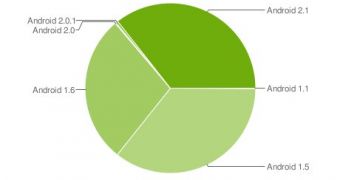On Monday, Internet giant Google has released an updated chart showing the percentage each flavor of its Android mobile operating system accounts for when it comes to their presence on mobile phones on the market. Six different versions of Android are currently in use on the wide range of handsets available on the market, yet it seems that only three of them are enjoying increased usage.
The data offered by the aforementioned chart was collected during a 14-day period ended May 17. According to Google, the figures are based on the number of Android-based mobile phones that accessed the Android Market during this period of time, and is meant to offer developers an image of the device distribution out there.
The Android 2.1 version of Google's mobile operating system accounts for the widest distribution on handsets, with 37.2 percent usage on its side. On the second place the chart places Android 1.5, with 34.1 percent, followed by Android 1.6 on the third, with 28.0 percent. The other three flavors of the platform, namely Android 1.1, 2.0, and 2.0.1, account for much smaller shares, going in at 0.1, 0.2, and 0.4 percent, respectively.
The fragmentation of the OS is expected to be addressed in newer iterations, starting with the upcoming Android 2.2 (Froyo). There are great chances that Google might chose a different upgrade process than before, when the delivery of updates was in manufacturers' hands. Moreover, not to long ago the company announced that fewer new versions of the OS would be pushed out to the market, in an attempt to solve the issue.
As for the chart, it can be seen on the Android Developers website here, where Google states the following: “This page provides data about the relative number of active devices running a given version of the Android platform. This can help you understand the landscape of device distribution and decide how to prioritize the development of your application features for the devices currently in the hands of users.”

 14 DAY TRIAL //
14 DAY TRIAL //